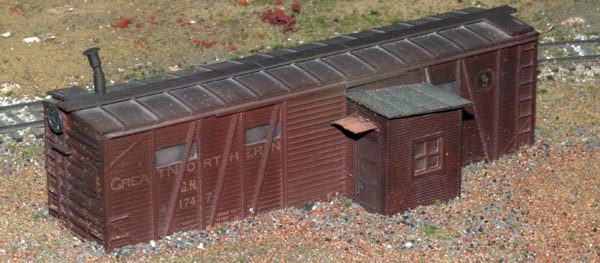Black Jack's Bar Outside Wolf Creek MT
Part 2
2) Model Building Black Jacks Bar in HO Scale
By Paul A. Wussow
Black Jack's Bar was created by kitbashing a Roundhouse 50' Outside Braced Double Steel Door Boxcar kit shown here in Western Pacific livery. (Figure 1)

Figure 1
The kit was cut down in length by the size of one door and reassembled (Figure 2).

Figure 2
Because the Roundhouse car is a one piece casting I had to cut between the boxcar doors on each side which are not directly across from each other. I carefully cut between the doors on the entry way side of the car and across the roof. I then had to cut along the roof line to meet the vertical cut along the door line on the other side (Figure 3).

Figure 3
The roof line and the roof walk were cut along the ribs. The cuts are to the right of the red lines (Figure 4)

Figure 4
In order to add the windows I drilled holes for a saw blade and then cut out the windows with a fine scroll saw blade. After cutting the window holes I then used a jeweler’s file to make them square (Figure 5)

Figure 5
To add glazing I fitted the windows with sheet styrene that had been frosted by sanding the inside and dusted with Dulcoat to look as if they were never washed (Figure 6).

Figure 6
For the entry area, I scratch built a vestibule out of sheet styrene, Model Die Casting/Roundhouse window casting, paper stock and Campbell corrugate as roof material (Figure 7, 8 and 9).

Figure 7 Figure 8

Figure 9
I braced the inside of the entry way with wood braces to keep it square and add support. The iron outside bracing of the car was cut away to fit the entry way against the boxcar. I painted the model and weathered it during and after construction. The building may be lit with lamps from under the structure and the light in the entry will be different than the lights in the bar area. Detail parts came from many leftovers that I found in my junk box.
To mount Black Jack’s Bar on the module I had to cut a foundation space into the foam (Figure 10)
.

Figure 10
After inserting the building I added dirt, earth and gravel to fill in the space around the foundation cutout. I finished the mounting of the building with some foliage of different colors and added more dirt on top to dull the colors (Figures 11 and 12)

Figure 11

Figure 12
I found it interesting that in Maclean's book he refers to "the sign of the Great Northern Railroad, a mountain goat gazing through a white beard on a world painted red." As I was planning this scene, I learned that the Great Northern may not have adopted the goat for their cars until well after 1937. I would guess the reference comes from seeing the goat sign on Great Northern Freight cars during Maclean’s yearly trip from the University of Chicago to their summer home at Seeley Lake, Montana. This goat works for the story, A River Runs Through It, the same way the sign with the Oculists’ glasses known as the eyes of Dr. T. J. Eckleburg worked for F. Scott Fitzgerald in The Great Gatsby. Did the Great Northern Goat watch and pass judgment on the frequent customers of Black Jack’s Bar? Only the goat knows for sure.
So, this building, built from a kitbashed railroad car, is true to a fictional prototype of a watering hole in the back woods of Montana along the Prickly Pear Creek which out there is pronounced Crick.
- Fictional Story of Model Structure
- Model Building in HO Scale
- Module for teaching Model Railroad Photography
- Fictional accounts of life in the summer of 1937

Update 12/27/14


